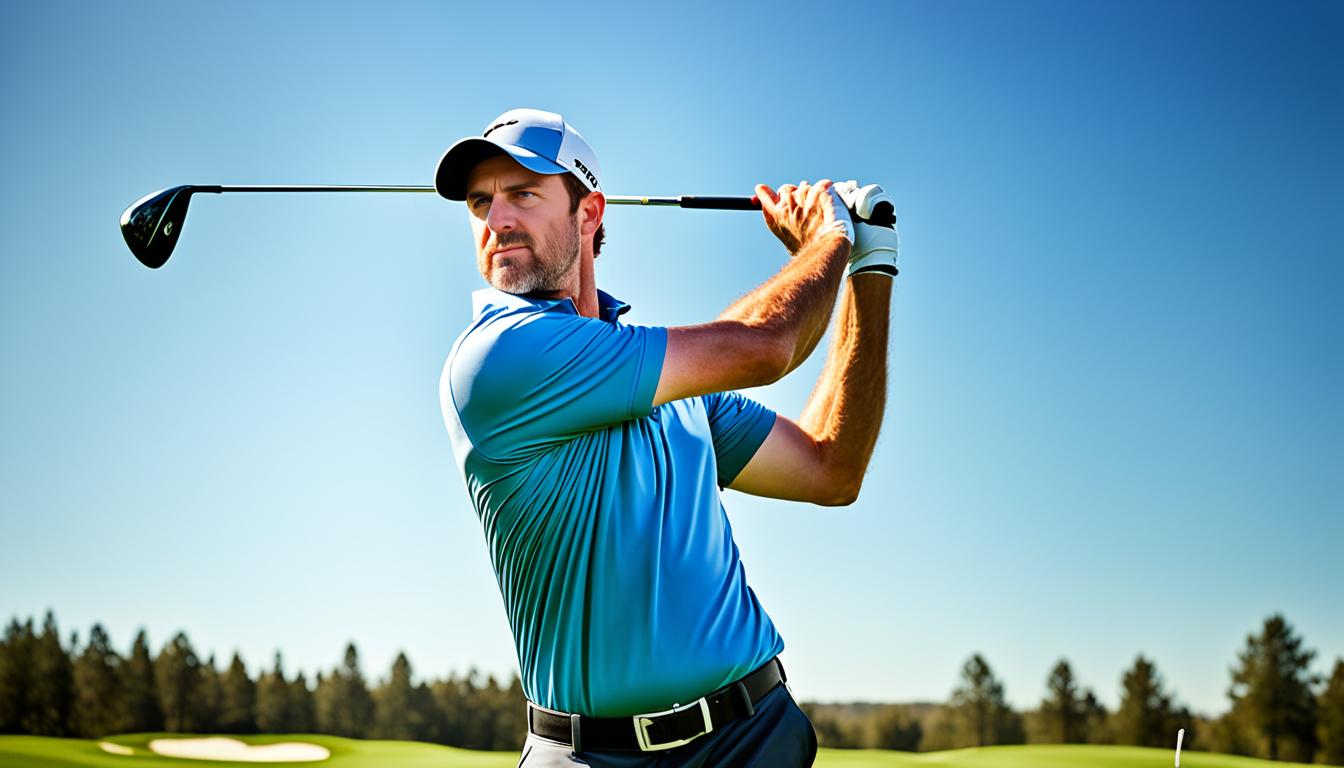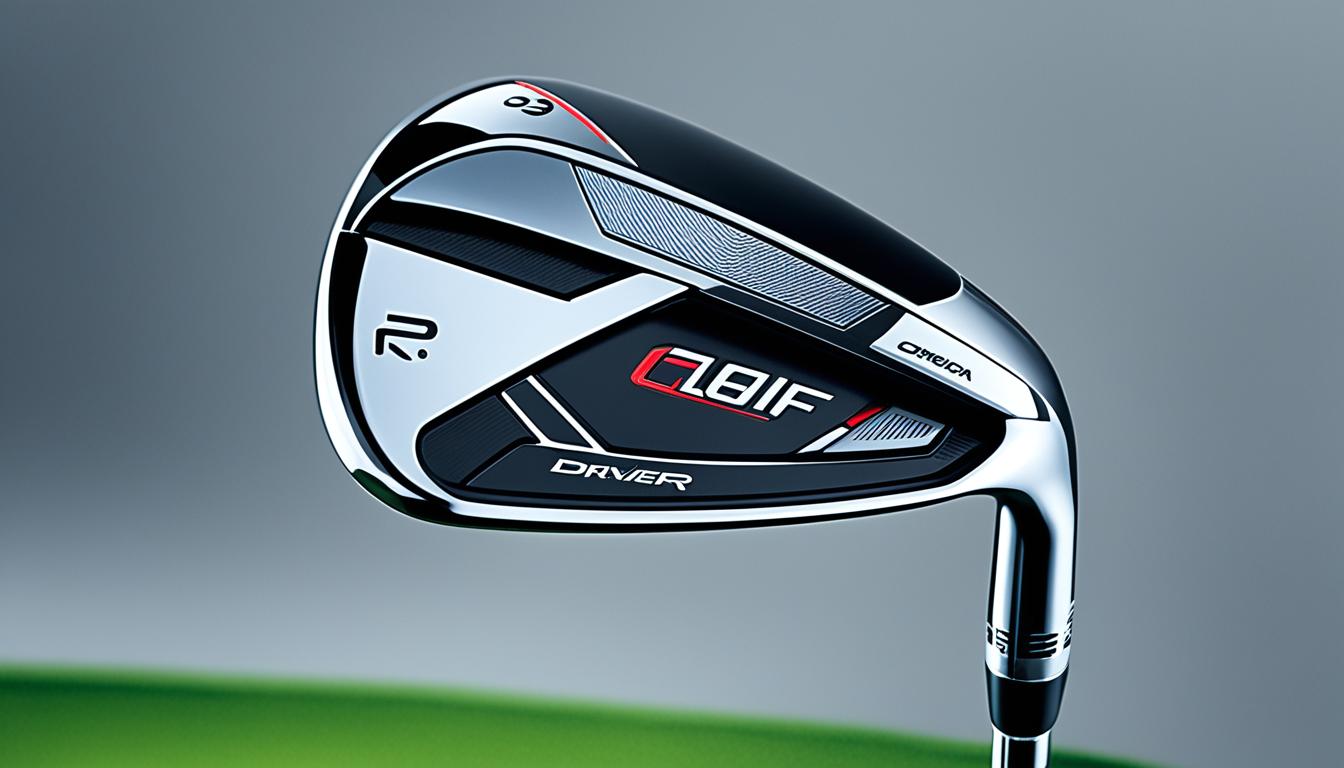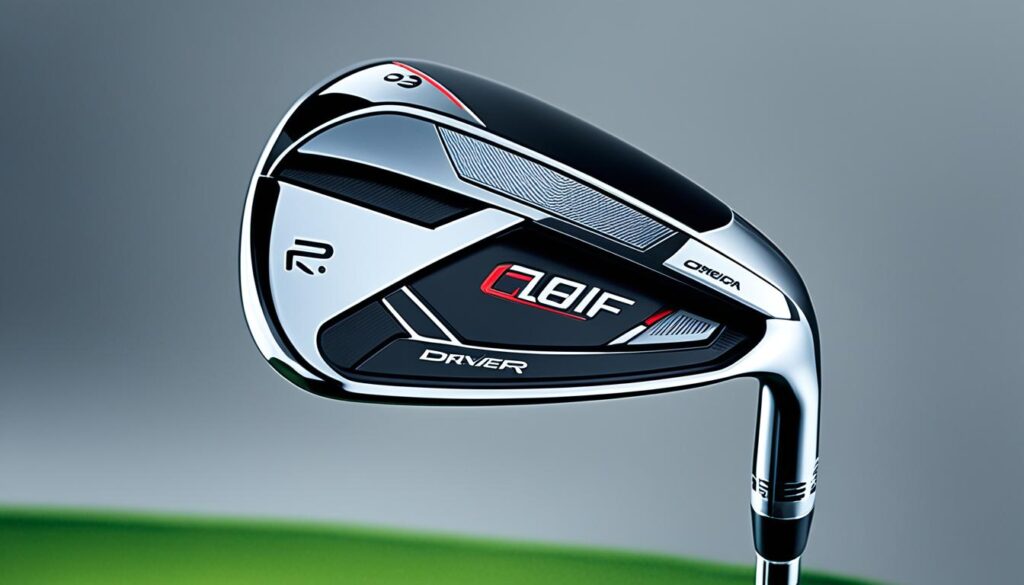Are you finding it tough to really hit the ball with your driver? Learning to swing a golf driver well is a mix of art and science. It needs the right technique, timing, and a good feel. But everyone can start hitting the ball far down the fairway with the right basics, even those just starting.
This guide will take you step by step through the important parts of a great driver swing. You’ll discover the best ways to get more speed out of your club while staying balanced and in control. This is how you’ll hit those drives that impress your friends. Together, we’ll look at the essential driver swing mechanics, the launch conditions you need, and great drills for a loose, easy swing.
Key Takeaways
- Establish a solid, athletic position at address with a wide, balanced stance.
- Focus on a smooth, rhythmic swing tempo and full release for maximum clubhead speed.
- Sequence your weight shift and body rotation properly to create effortless power.
- Control launch angle and spin rate for an optimal ball flight and distance.
- Use targeted drills and video analysis to ingrain the feels of a technically sound driver swing.
Table of Contents
- 1 The Importance of Proper Driver Swing Mechanics
- 2 Setting Up for Success: The Driving Stance
- 3 Mastering the Takeaway and Backswing
- 4 The Transition: Loading for Power
- 5 The Downswing: Unleashing Speed
- 6 Impact: Delivering an Explosive Strike
- 7 The Follow-Through: Finishing the Swing
- 8 Drills and Exercises for Improving Your Driver Swing
- 9 Equipment Considerations for Driving
- 10 Common Driving Faults and How to Fix Them
- 11 Incorporating Video Analysis and Professional Instruction
- 12 The Fun of Launching Powerful Drives
The Importance of Proper Driver Swing Mechanics
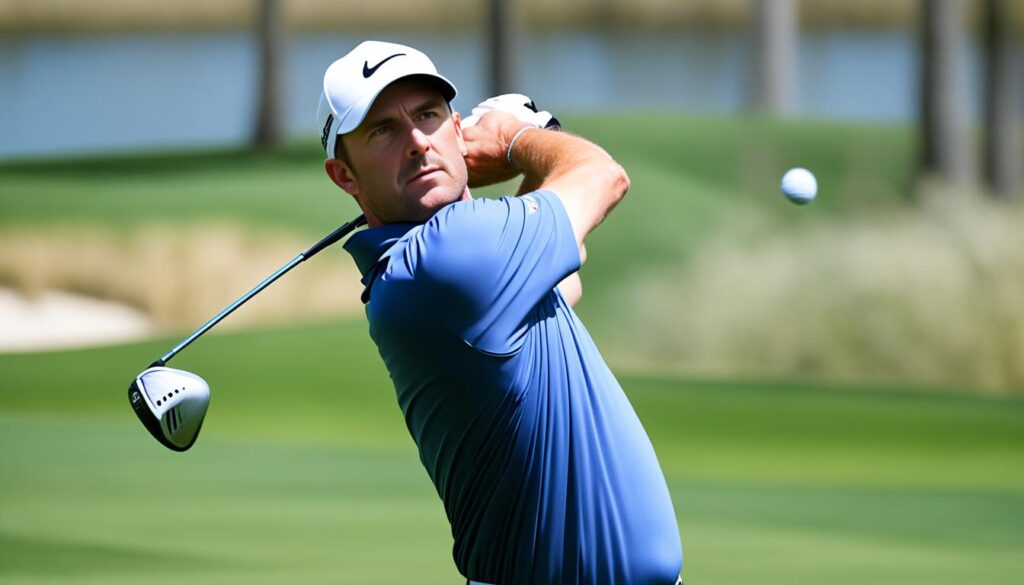
Learning the driver swing can transform a golfer’s game. It helps them hit the ball further and more accurately. At first, it might be hard, but knowing the basics is critical to hitting the ball well.
It’s important to swing in the correct order and time. Doing so helps the body’s main muscles work right. A good swing makes the club go from the inside out and up a little. This is the best way to launch the ball for the longest and straightest hits.
Understanding the Fundamentals
To get the most out of their driver, golfers need to understand some details. They should know the right path, plane, and arc for their swing. These details help the swing go smoothly from start to hit.
Michael Metz, a top Golf Instructor, says, “Controlling the club’s path is critical for hitting straight. Swinging the club from the inside out and up a bit makes the ball go further and straighter.”
Achieving Optimal Distance and Accuracy
Turning and using big muscles right is how golfers hit the ball hard. Metz adds, “Turning the body well lets physical energy go into the ball. This makes it go far and stay on target.”
Even a small speed increase can add yards to the ball’s flight. Hit the ball in the center of the club to make it go even farther. This is because it speeds up and can travel more.
| Clubhead Speed (mph) | Shaft Flex |
|---|---|
| >105 | X Stiff |
| 97-104 | Stiff |
| 84-96 | Regular |
| 72-83 | Senior |
| Ladies |
Getting the right swing mechanics helps golfers use their driver well. This leads to hitting more fairways and lower scores.
Setting Up for Success: The Driving Stance
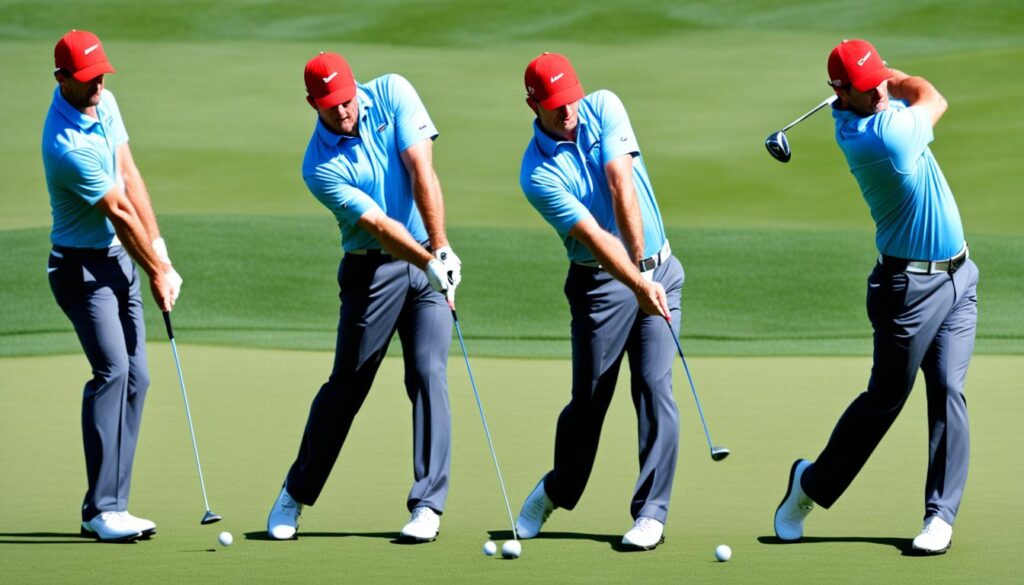
Starting the driver swing right is all about a solid setup. A good stance lets me swing smoothly and with control. At Deer Creek Golf Club, we’re taught to stand shoulder-width apart. This gives us more balance with the driver.
Ball Position for an Upward Strike
For a great upward strike and more distance, the ball goes by my lead heel. This position helps me hit upwards on the ball, squeezing it well.
Grip and Posture Essentials
Now, let’s talk about the grip and posture. I use a relaxed but firm grip on the driver. I keep an athletic pose with a bit of a knee bend. It’s key that my shoulders point straight ahead too. I also make sure the tee is high enough for that upward hit. This sets me up for a strong shot.
| Driver Setup | Description |
|---|---|
| Stance Width | Shoulder-width apart for balance |
| Ball Position | Forward, opposite lead heel |
| Grip | Relaxed but secure |
| Posture | Athletic, slight knee bend |
| Alignment | Shoulders parallel to target line |
| Tee Height | Promotes upward strike angle |
The setup might be basic, but it’s super important. At Deer Creek, they tell us not to skip it. Focus on the basics, practice them, and stay consistent. They even say it’s good to get tips from the PGA pros to improve.
Mastering the Takeaway and Backswing
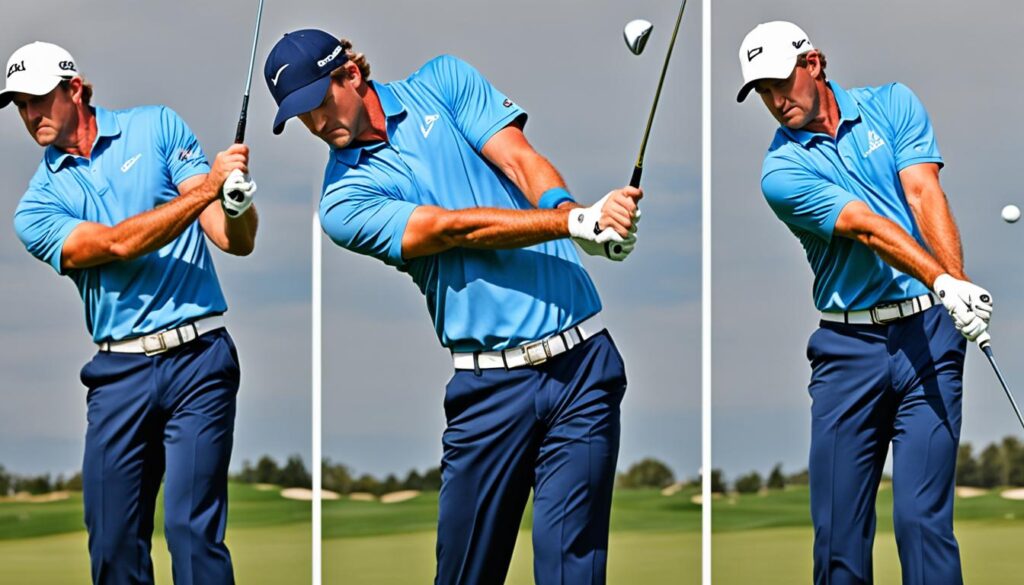
The takeaway is crucial for a great driver swing, setting the stage for power and accuracy. It starts my smooth, rhythmic backswing and ensures I unwind well. I choose between a one-piece or two-piece takeaway, each with its benefits.
One-Piece or Two-Piece Takeaway
In the one-piece takeaway, I move my arms, shoulders, and body away from the ball in one go. It’s a unified movement that keeps my swing on track. The two-piece approach involves hinging my wrists early to create a wider swing arc. Yet, it needs more skill to keep everything in sync.
Wrist Hinge and Arm Extension
For a solid takeaway, I must hinge my wrists properly and extend my arms fully. A good wrist hinge gives depth to my backswing, and extension keeps the club on the right path. Missing these steps limits my backswing and causes problems.
Coiling and Weight Shift
During the backswing, I coil my shoulders and hips against my trailing foot, transferring weight to my back side. This coiling action loads power by stretching my core muscles. It ensures a smooth unwinding for the downswing.
| Backswing Movements | Benefits |
|---|---|
| Wrist Hinge | Generates width and depth in backswing |
| Arm Extension | Maintains ideal swing plane |
| Shoulder Turn | Coils and loads power |
| Hip Turn | Shifts weight, creates torque |
By mastering wrist hinge, arm extension, and coiling, I create a powerful backswing. This sets me up for great shots on the course.
The Transition: Loading for Power
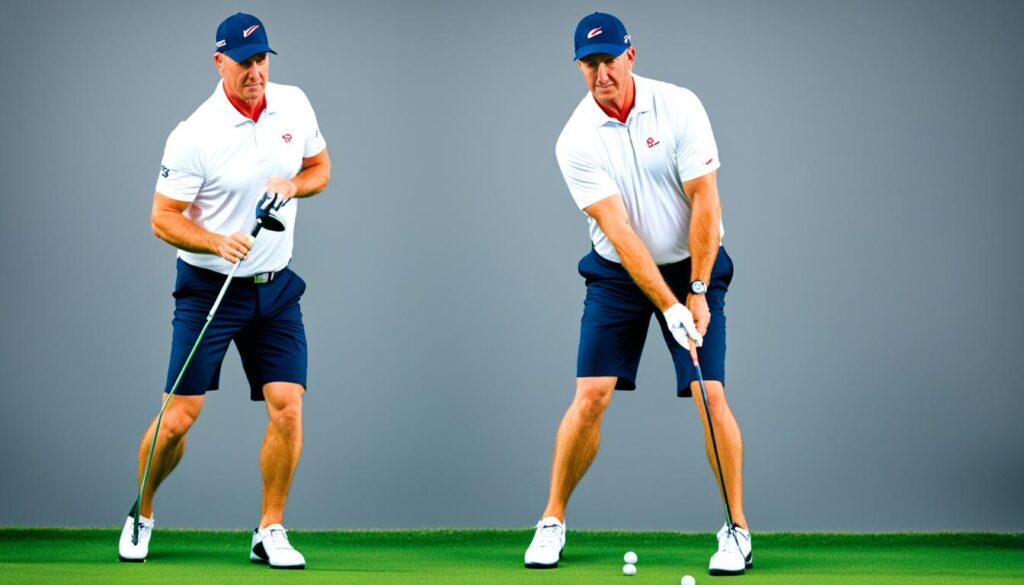
The transition is an important moment in golf where you store power for later. At the top of the backswing, hips and shoulders must fully turn. This makes sure your core is fully coiled, ready to release energy with perfect timing on the downswing.
Hip and Shoulder Turn
Technique is crucial, says Gerina Piller, a US Solheim Cup member. She focuses on turning, not just moving sideways, inspired by baseball. Piller tells players to build speed between 7 o’clock and 4 o’clock on a clock’s face. This sets up the core coil for a powerful downswing.
Proper Weight Transfer
As you turn, push the ground with your back foot to send weight forward. Pros shift their weight so that it’s mostly on their lead foot very early in the downswing. This weight distribution is a big deal for how well you hit the ball.
This move helps store energy in your legs and core. Piller says it’s key for loading and then releasing power in your swing. Her method is all about using your body right to get that smooth, easy power.
The Downswing: Unleashing Speed
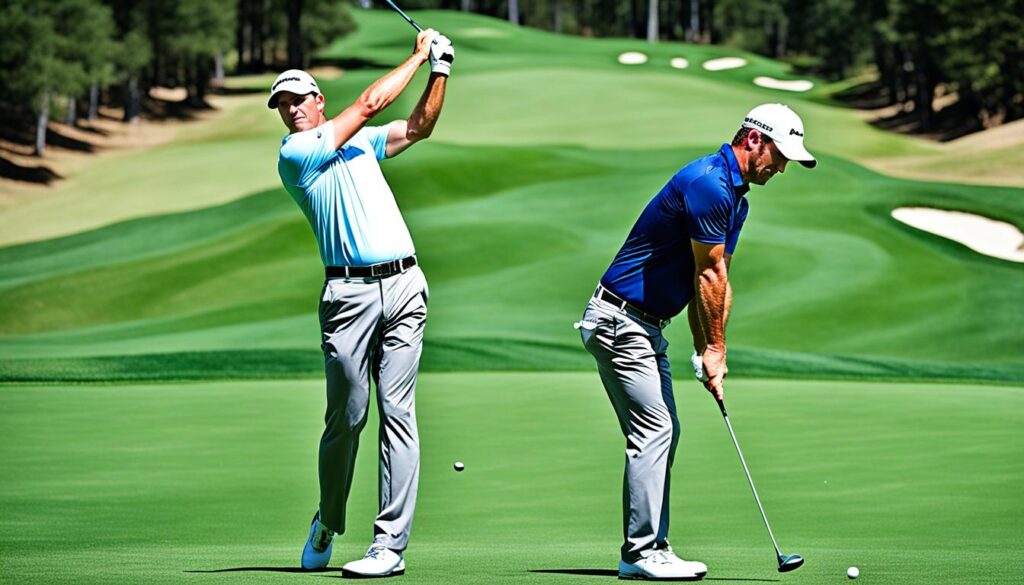
The downswing is critical for me to hit the ball far. As my hips turn towards the target, my arms and club follow. This makes the club lean a lot, storing up power. When everything is wound up, I can let the club fly fast at the ball.
As I turn fast, I need to keep my balance and posture. This lets me hit the ball right on with a lot of power. The downswing is when I use all my built-up energy.
Unwinding the Hips
The downswing starts with my hips turning fast towards the target. This move causes a lot of power. It helps me hit the ball really far. This power comes from my hips moving the club in a special way.
Releasing the Clubhead
My hips turn really fast, but my arms lag a bit. This creates a brief pause in the swing, adding more power. Then, I quickly move my arms to hit the ball just right. It’s like a whip, giving great speed to the clubhead.
Maintaining Balance and Posture
As I hit the ball, I make sure to keep strong and balanced. This is really important. My body moves a lot, but I stand steady. This keeps my hit accurate.
| Swing Component | Key Statistic |
|---|---|
| Clubhead Speed | 60% generated through downswing release |
| Lag Angle | Accounts for over 60% of clubhead speed |
| Shaft Lean | Created by hip unwind ahead of upper body |
| Weight Transfer | Aggressive shift to front foot unleashes power |
Impact: Delivering an Explosive Strike
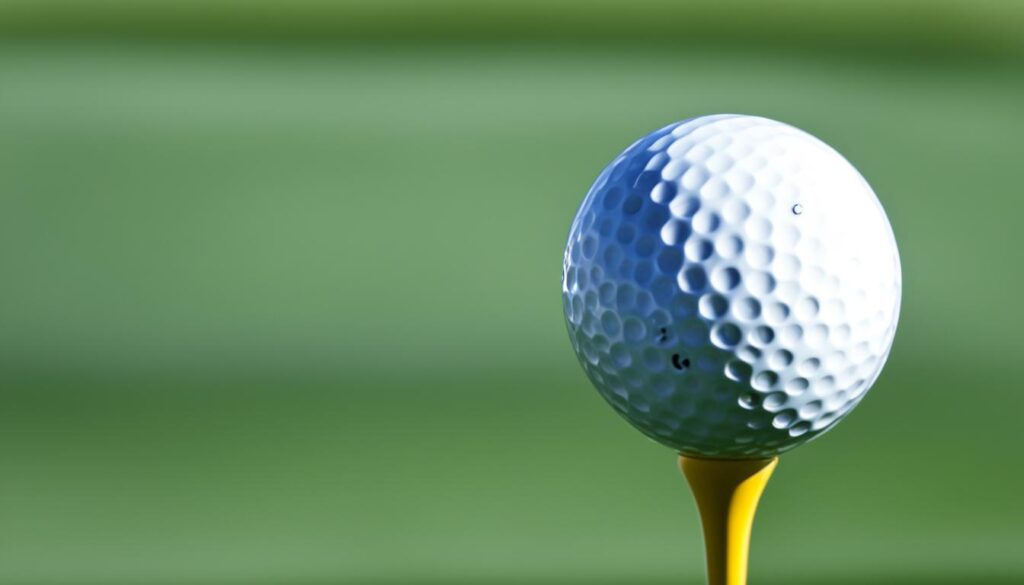
At impact, power and precision come together in a thrilling moment. This happens when we swing the club fast, hitting the ball just right. As a result, the ball shoots off at high speeds. Getting this right means controlling the club’s angle as it hits the ball. This way, we ensure the ball flies far and rolls just as far.
Hitting the ball straight through impact makes it fly straight. But errors in our swing can make the ball go off track. For a great shot, it’s important to hit slightly down on the ball, like expert golfers do. They aim to hit the ball with a slight downward angle, about 1.3 degrees.
| Angle of Attack | Ball Flight Characteristics |
|---|---|
| Positive (+) | Higher launch, more spin, less roll |
| Neutral (0) | Optimal compression, spin, and roll |
| Negative (-) | Lower launch, less spin, more roll |
Teeing the ball too high and swinging up too much is a common mistake. It leads to hits that are all over the place. Perfecting your impact position by practicing how you swing helps. Changing where you stand and how you hit the ball can help, but one strong, consistent hit is critical.
- Tee the ball lower, around knee height, to encourage a descending blow.
- Focus on a neutral ball position, favoring the inside of my front foot.
- Maintain an athletic, balanced finish to fully release the clubhead.
With lots of practice, you can learn to hit the ball just right. Achieving a perfect strike makes golf exciting. It combines far distances with great accuracy. This is what makes playing the game so much fun.
The Follow-Through: Finishing the Swing
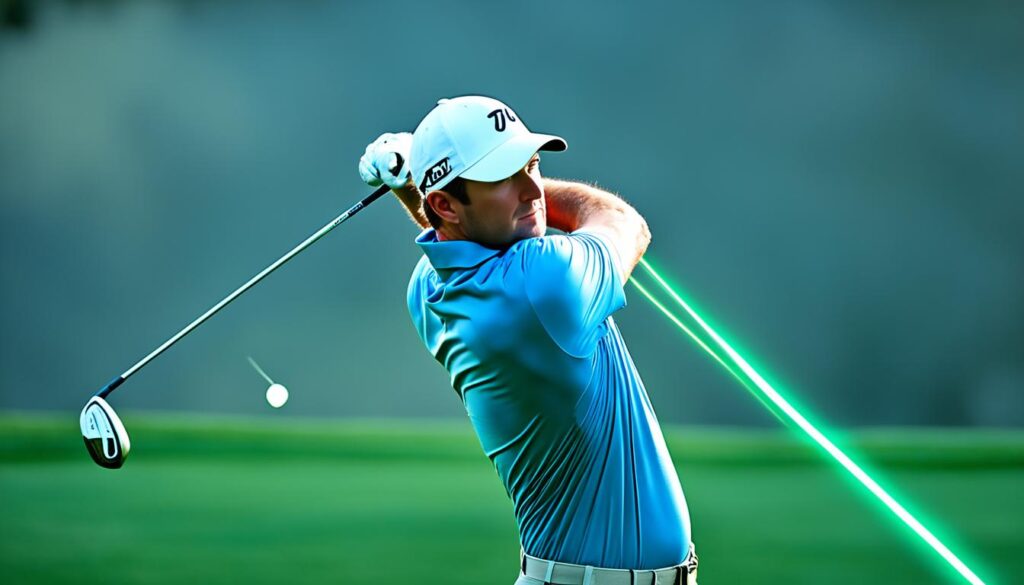
The follow-through is critical to finish your swing. It ensures the body, and clubhead fully complete their motion. Staying balanced helps transfer energy well, increasing your power.
Balanced Deceleration
When hitting the ball, my arms reach towards the target fully. This lets the club follow the right swing path. But, this shouldn’t happen too fast. A balanced deceleration is what you need. It helps you slow down the club smoothly after hitting the ball. This keeps you in control and protects your joints and muscles.
Holding the Finish Position
After hitting, holding the finish position is important. It means keeping your arms and body straight for a moment. Also, shift your weight fully to your front foot. This step is good for learning a connected swing. It improves how you remember and repeat your swing.
In the follow-through, body and arm position are very important. Your right shoulder should be lower. Arms must be straight. This position shows you’ve shifted your weight well. It also helps the club turn right, improving how accurate and powerful your shot is.
| Key Elements | Benefits |
|---|---|
| Balanced deceleration | Maintains control, reduces strain |
| Holding finish position | Reinforces complete release, improves consistency |
| Proper arm and body positioning | Enables optimal club release, enhances power and accuracy |
Though the follow-through looks minor, it’s crucial. Practice with impact bags can make a big difference. By mastering your follow-through, you improve your drives. This leads to consistently powerful and accurate shots.
Drills and Exercises for Improving Your Driver Swing
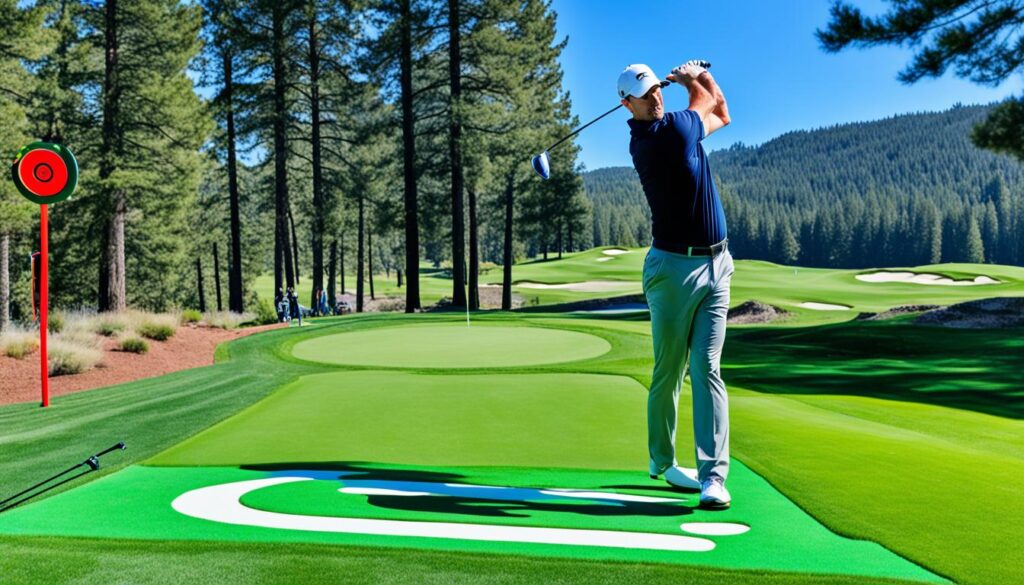
To boost your driver swing, use dedicated drills and exercises. They help you get the right feel and feedback. I’ve aimed for more distance with my tee shots, knowing focused training aids are important for development.
Tee Drill for Rhythm and Tempo
A simple yet effective drill is to swing at a tee without a ball. This helps your rhythm and tempo, builds a proper swing path and swing plane, and keeps your feel of the full release. I use this “mini swing” practice at the range to keep my tempo smooth throughout.
Swing Path and Plane Drills
To nail down the perfect swing path and swing plane, I turn to alignment sticks. These training aids give me instant feedback on my swing direction and body position. For instance, the Driver Swing Path Drill helps me swing along a rail for an inside path. The Headcover Under the Arm Drill teaches me to keep a consistent spine tilt.
Other drills such as Hitting Up on the Ball, Step Forward, and One Leg Drive are great too. They focus on the right moves for a strong and controlled hit with your driver. Regular, focused practice makes these techniques a natural part of your game, leading to powerful drives.
Aiming for impressive distances like top players does? The big key is to keep the ball in the middle of the fairway. Working on these drills helps perfect your swing path, plane, rhythm, and tempo. This means your driver shots hit the mark time and again.
Equipment Considerations for Driving
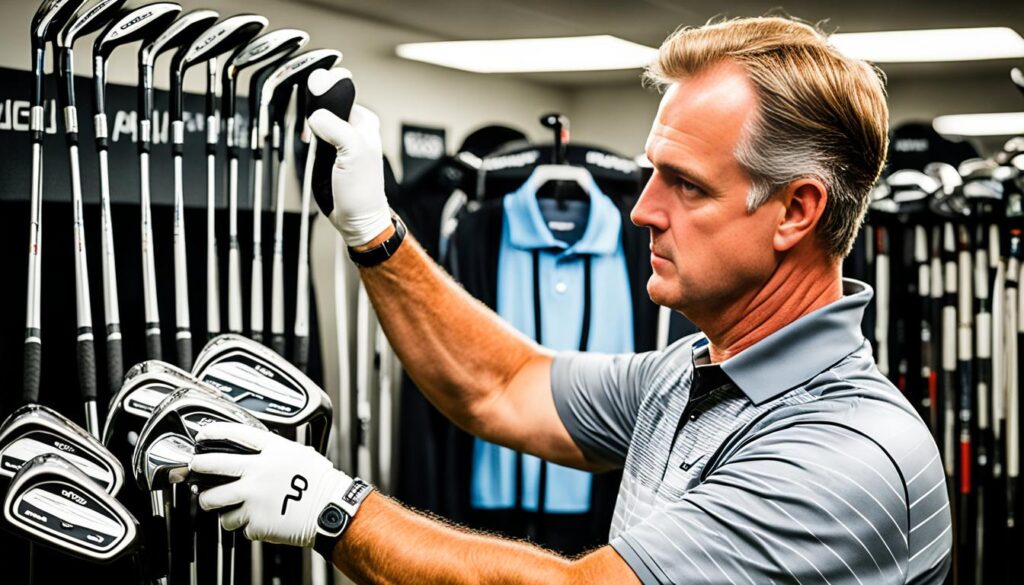
Choosing the right equipment is critical for great driving. Your driver affects how your ball moves and if you gain extra yards. So, picking the right one is super important.
Choosing the Right Driver
The driver head’s design, size, and loft angle matter a lot. They affect how your ball launches. The TaylorMade SLDR is known for its great performance.
A TaylorMade SLDR setup costs around $575. Yes, it’s not cheap, but it’s a good investment. It helps you avoid problems later, like a worn-out shaft.
Shaft and Loft Options
The shaft is also crucial. Weight, flexibility, and where it bends affect how you hit the ball. Getting fitted on a launch monitor is priceless. It matches you with the right shaft and loft based on your swing.
I suggest lofts between 12-15 degrees for shorter hits. And 8-10 degrees for longer drives. But remember, each person’s swing is different.
Start with general shaft and driver length tips. But the best setup is one that fits you perfectly. Don’t forget about the gap between your driver and fairway woods. It’s crucial for your game plan and hitting the right distances.
Common Driving Faults and How to Fix Them
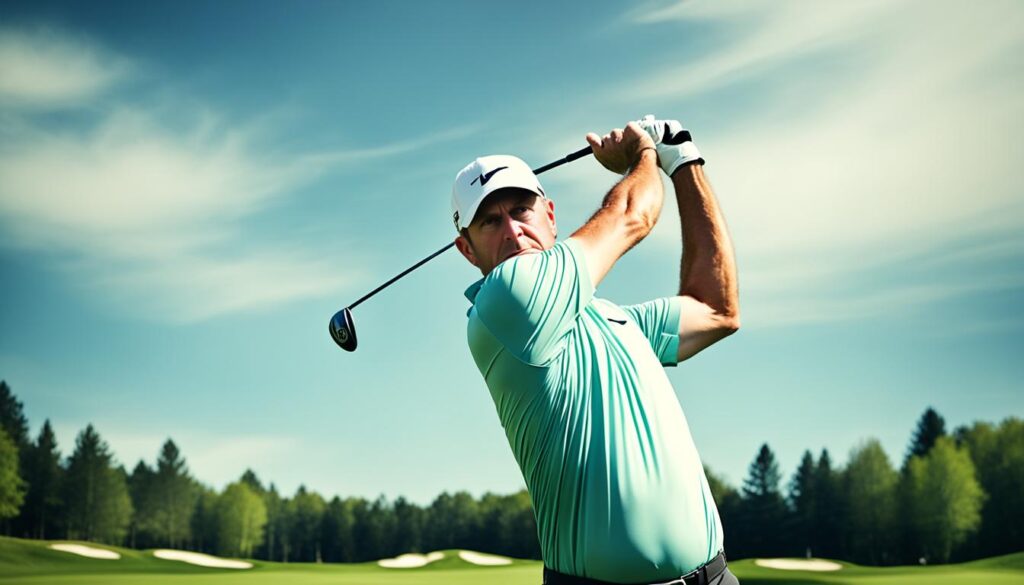
Being a golfer, I know the hassle of driving faults too well. Even experienced players face issues like slices, hooks, pushes, and pulls. These mistakes can mess up a good game. But, don’t worry! With some tips and practice, you can beat these problems. Then, you’ll enjoy hitting strong, accurate drives.
An overly steep swing causes banana balls. It leads to ballooning shots that don’t go far. A cast swing makes drives weak and inaccurate.
Understanding the issues behind these faults is critical. Problems might be in how you hold the club, swing, or the angle of the club face. By working on these problems, you can fix your game over time.
| Fault | Cause | Fix |
|---|---|---|
| Slice | Open clubface at impact, outside-to-in swing path | Strengthen grip, adjust alignment, weight transfer |
| Hook | Closed clubface at impact, inside-to-out swing path | Weaken grip, aim further right, hold face open |
| Push | Lack of body rotation, early release | Improve weight shift, delay release |
| Pull | Over-rotation, casting | Slow tempo, maintain lag |
Try simple fixes like changing your setup, ball position, or focusing on weight shift. These can help hit the ball straighter. Also, watching videos of your swing can point out what to fix early.
Small changes can make a big difference in your game. Keep learning, adjusting, and practicing. Soon, your powerful, accurate drives will impress everyone you play with.
Incorporating Video Analysis and Professional Instruction
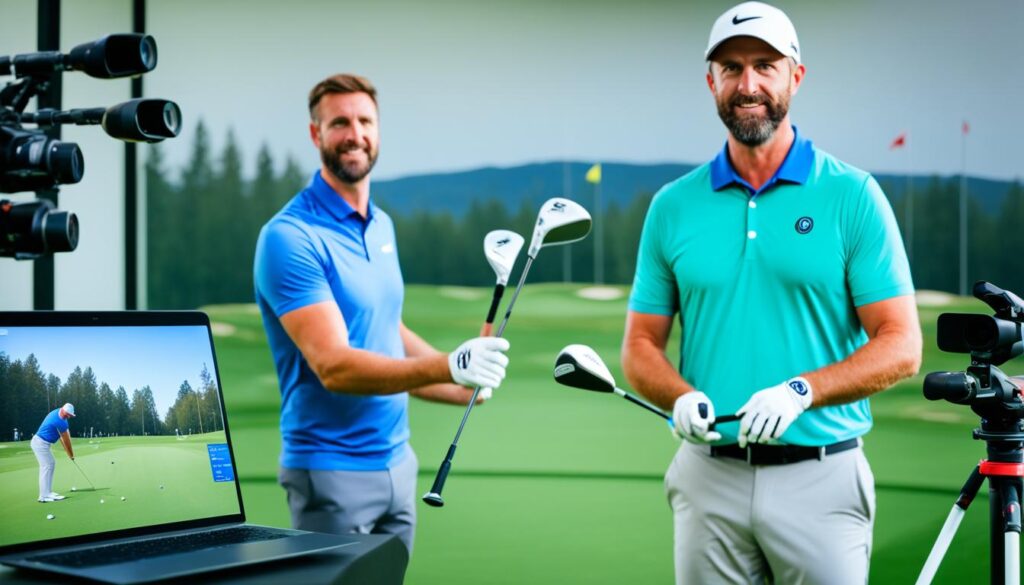
Doing drills and practicing help learn the right driver swing. But, video analysis finds problems you might miss. Watching your swings with a coach helps see what needs work. This makes getting better at golf easier.
Professional instruction is critical to learning faster. A good coach can see small issues in your swing that you can’t. With their help and hard work, you can improve your golf scores.
Today, video analysis is better than ever, thanks to modern tech. It lets us record golf swings clearly and slowly. Coaches can then check swings from different angles. This helps in finding and fixing swing mistakes.
Also, online coaching is more common now. Sites like CoachNow make it easy to get advice from top PGA professionals. They provide drills and tips to improve your game from any location.
| Coaching Method | Benefits |
|---|---|
| In-person lessons |
|
| Remote coaching |
|
Using video analysis and good coaching can speed up your golf improvement. With focused work and expert advice, hitting long and straight drives is within reach.
The Fun of Launching Powerful Drives
Striking the ball perfectly off the tee with my driver gives me joy like nothing else. The right ball position and shoulder tilt, as shown in this guide, help me hit my drives just right. This launches the ball high and long.
Learning to hit strong drives in golf is very rewarding. It feels great to hit the ball farther than my friends. By practice and improving my technique, I can hit the ball far more often.
Seeing the ball fly perfectly off the clubface fills me with joy. It’s amazing whether the ball goes straight, or I shape my shot. A solid drive gives me confidence for the rest of the hole.
